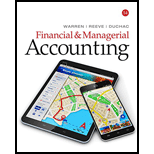
Financial & Managerial Accounting
14th Edition
ISBN: 9781337119207
Author: Carl Warren, James M. Reeve, Jonathan Duchac
Publisher: Cengage Learning
expand_more
expand_more
format_list_bulleted
Question
Chapter 19, Problem 19.18EX
(A)
To determine
Cost-Volume-Profit Analysis: It is a method followed to analyze the relationship between the sales, costs, and the related profit or loss at various levels of units sold. In other words, it shows the effect of the changes in the cost and the sales volume on the operating income of the company.
To determine: the maximum possible operating loss.
(B)
To determine
To compute: the maximum possible operating profit.
(C)
To determine
To construct: a cost-volume-profit chart.
(D)
To determine
To estimate: the break-even sales (units) by using the cost-volume-profit chart constructed in part (C).
Expert Solution & Answer
Want to see the full answer?
Check out a sample textbook solution
Students have asked these similar questions
Can you help me solve this general accounting problem using the correct accounting process?
Can you help me solve this general accounting problem using the correct accounting process?
Please explain the solution to this general accounting problem with accurate principles.
Chapter 19 Solutions
Financial & Managerial Accounting
Ch. 19 - Describe how total variable costs and unit...Ch. 19 - Which of the following costs would be classified...Ch. 19 - Describe how total fixed costs and unit fixed...Ch. 19 - In applying the high-low method of cost estimation...Ch. 19 - If fixed costs increase, what would be the impact...Ch. 19 - Prob. 6DQCh. 19 - If the unit cost of direct materials is decreased,...Ch. 19 - Both Austin Company and Hill Company had the same...Ch. 19 - Prob. 9DQCh. 19 - Prob. 10DQ
Ch. 19 - High-low method The manufacturing costs of...Ch. 19 - Contribution margin Lanning Company sells 160,000...Ch. 19 - Prob. 19.3BECh. 19 - Prob. 19.4BECh. 19 - Prob. 19.5BECh. 19 - Prob. 19.6BECh. 19 - Margin of safety Liu Company has sales of...Ch. 19 - Classify costs Following is a list of various...Ch. 19 - Identify cost graphs The following cost graphs...Ch. 19 - Prob. 19.3EXCh. 19 - Identify activity bases From the following list of...Ch. 19 - Identify fixed and variable costs Intuit Inc....Ch. 19 - Prob. 19.6EXCh. 19 - High-low method Ziegler Inc. has decided to use...Ch. 19 - High-low method for a service company Boston...Ch. 19 - Contribution margin ratio A. Young Company budgets...Ch. 19 - Contribution margin and contribution margin ratio...Ch. 19 - Prob. 19.11EXCh. 19 - Prob. 19.12EXCh. 19 - Break-even sales Currently, the unit selling price...Ch. 19 - Prob. 19.14EXCh. 19 - Prob. 19.15EXCh. 19 - Break even analysis for a service company Sprint...Ch. 19 - Prob. 19.17EXCh. 19 - Prob. 19.18EXCh. 19 - Prob. 19.19EXCh. 19 - Prob. 19.20EXCh. 19 - Prob. 19.21EXCh. 19 - Break-even sales and sales mix for a service...Ch. 19 - Margin of safety A. If Canace Company, with a...Ch. 19 - Prob. 19.24EXCh. 19 - Operating leverage Beck Inc. and Bryant Inc. have...Ch. 19 - Classify costs Seymour Clothing Co. manufactures a...Ch. 19 - Break-even sales under present and proposed...Ch. 19 - Prob. 19.3APRCh. 19 - Prob. 19.4APRCh. 19 - Prob. 19.5APRCh. 19 - Contribution margin, break even sales,...Ch. 19 - Classify costs Cromwell Furniture Company...Ch. 19 - Prob. 19.2BPRCh. 19 - Break even sales and cost-volume-profit chart For...Ch. 19 - Prob. 19.4BPRCh. 19 - Sales mix and break even sales Data related to the...Ch. 19 - Prob. 19.6BPRCh. 19 - Prob. 1ADMCh. 19 - Break-even subscribers for a video service Star...Ch. 19 - Prob. 3ADMCh. 19 - Prob. 19.1TIFCh. 19 - Prob. 19.3TIF
Knowledge Booster
Similar questions
- Hii teacher please provide for general accounting question answer do fastarrow_forwardexplain properly all the answer for General accounting question Please given fastarrow_forwardHerbert expects to increase sales in the coming year by 15% while keeping fixed operating costs constant at $15.6 million.arrow_forward
- General accountingarrow_forwardHillwood Textiles computes its plantwide predetermined overhead rate annually based on direct labor hours. At the beginning of the year, it was estimated that 42,000 direct labor hours would be required for the period's estimated level of production. The company also estimated $525,000 of fixed manufacturing overhead cost for the coming period and variable manufacturing overhead of $3.00 per direct labor hour. Hillwood’s actual manufacturing overhead cost for the year was $670,000, and its actual total direct labor hours were 43,200. Compute the company’s plantwide predetermined overhead rate for the year.arrow_forwardAccurate Answerarrow_forward
- Elizabeth Appliance Company had a net income of $68,400 and net sales of $480,000. Compute the relationship of net income to net sales.arrow_forwardUsing the weighted-average valuation method the equivalent units produced by the department were _________Units.arrow_forwardI am looking for the correct answer to this general accounting question with appropriate explanations.arrow_forward
arrow_back_ios
SEE MORE QUESTIONS
arrow_forward_ios
Recommended textbooks for you
 Managerial AccountingAccountingISBN:9781337912020Author:Carl Warren, Ph.d. Cma William B. TaylerPublisher:South-Western College Pub
Managerial AccountingAccountingISBN:9781337912020Author:Carl Warren, Ph.d. Cma William B. TaylerPublisher:South-Western College Pub Financial And Managerial AccountingAccountingISBN:9781337902663Author:WARREN, Carl S.Publisher:Cengage Learning,
Financial And Managerial AccountingAccountingISBN:9781337902663Author:WARREN, Carl S.Publisher:Cengage Learning, Survey of Accounting (Accounting I)AccountingISBN:9781305961883Author:Carl WarrenPublisher:Cengage Learning
Survey of Accounting (Accounting I)AccountingISBN:9781305961883Author:Carl WarrenPublisher:Cengage Learning Managerial Accounting: The Cornerstone of Busines...AccountingISBN:9781337115773Author:Maryanne M. Mowen, Don R. Hansen, Dan L. HeitgerPublisher:Cengage Learning
Managerial Accounting: The Cornerstone of Busines...AccountingISBN:9781337115773Author:Maryanne M. Mowen, Don R. Hansen, Dan L. HeitgerPublisher:Cengage Learning Cornerstones of Financial AccountingAccountingISBN:9781337690881Author:Jay Rich, Jeff JonesPublisher:Cengage LearningPrinciples of Accounting Volume 2AccountingISBN:9781947172609Author:OpenStaxPublisher:OpenStax College
Cornerstones of Financial AccountingAccountingISBN:9781337690881Author:Jay Rich, Jeff JonesPublisher:Cengage LearningPrinciples of Accounting Volume 2AccountingISBN:9781947172609Author:OpenStaxPublisher:OpenStax College

Managerial Accounting
Accounting
ISBN:9781337912020
Author:Carl Warren, Ph.d. Cma William B. Tayler
Publisher:South-Western College Pub

Financial And Managerial Accounting
Accounting
ISBN:9781337902663
Author:WARREN, Carl S.
Publisher:Cengage Learning,

Survey of Accounting (Accounting I)
Accounting
ISBN:9781305961883
Author:Carl Warren
Publisher:Cengage Learning

Managerial Accounting: The Cornerstone of Busines...
Accounting
ISBN:9781337115773
Author:Maryanne M. Mowen, Don R. Hansen, Dan L. Heitger
Publisher:Cengage Learning

Cornerstones of Financial Accounting
Accounting
ISBN:9781337690881
Author:Jay Rich, Jeff Jones
Publisher:Cengage Learning

Principles of Accounting Volume 2
Accounting
ISBN:9781947172609
Author:OpenStax
Publisher:OpenStax College